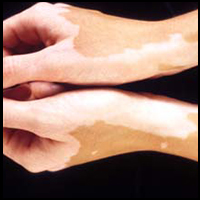Vitiligo is a very commonly seen skin disease where there is loss melanin pigment on outer layer of skin. The disease is also termed as Leucoderma and the skin of patients suffering from the disease develop white patches. The disease is painless, without any itching effects, and never causes any other physical harm to the patients suffering from it. Further, it can be also found the patients suffering from the disease live normal life like other people. Till date no germs or microbes are found responsible for the disease. In addition, the disease is also not caused due to impure blood and according to the studies the disease is not communicable.

The disease is hereditary and it can be often found if someone in family is having the disease others can also fall prey of it. According to various medical studies the disease is caused due destruction of melanocytes present in the skin. It is also said the disease is caused due to auto immune disorder where white blood cells of body by mistake start fighting with own body cells. The disease can be in three patterns namely focal pattern, segmental pattern, and generalized pattern. In focal pattern the white patches can be found in the specific region of body and it is limited to that particular area. In segmental pattern the white patches is spread over only one side of patients’ body. However, generalized pattern the white patches can be found on the both sides of the patients’ body. The white patches are mostly found in areas of body, which is mostly gets exposed to sun.
Although there is no permanent cure available for Vitiligo but can be found in several cases homeopathy proves to be best cure for the disease. Vira’s Homeopathy Clinic has best track record in providing best results in most of cases of Vitiligo.
Vitiligo generally appears in one of three patterns:
- Focal Pattern : The depigmentation is limited to one or only a few areas
- Segmental Pattern : Depigmented patches develop on only one side of the body
- Generalized Pattern : The most common pattern. Depigmentation occurs symmetrically on both sides of the body.
In addition to white patches on the skin, people with vitiligo may have premature graying of the scalp hair, eyelashes, eyebrows, and beard. People with dark skin may notice a loss of color inside their mouths.
Focal pattern vitiligo and segmental vitiligo remain localized to one part of the body and do not spread. There is no way to predict if generalized vitiligo will spread. For some people, the depigmented patches do not spread. The disorder is usually progressive, however, and over time the white patches will spread to other areas of the body. For some people, vitiligo spreads slowly, over many years. For other people, spreading occurs rapidly. Some people have reported additional depigmentation following periods of physical or emotional stress.
The diagnosis of vitiligo is made based on a physical examination, medical history, and laboratory tests.
A doctor will likely suspect vitiligo if you report (or the physical examination reveals) white patches of skin on the body-particularly on sun-exposed areas, including the hands, feet, arms, face, and lips. If vitiligo is suspected, the doctor will ask about your medical history. Important factors in the diagnosis include a family history of vitiligo; a rash, sunburn, or other skin trauma at the site of vitiligo 2 to 3 months before depigmentation started; stress or physical illness; and premature (before age 35) graying of the hair.

